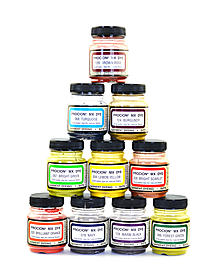I would like to know If it is possible to dye shirts with Italian ink? I make designer clothing and was wondering if there is a higher quality more expensive ink that people use.
Name: Mathias
This kit includes 3 small jars of dye, plus soda ash, which is used to permanently fix the Procion dye to natural fibers such as cotton and silk
Large 8-ounce jars of Procion dye are more economical; don't forget to purchase soda ash and urea, as well!


Procion MX Fiber Reactive Dye

Large 8-ounce jars of Procion dye are more economical; don't forget to purchase soda ash and urea, as well!

Procion MX Fiber Reactive Dye
Country or region: United States
Message: Hello! I would like to know If it is possible to dye shirts with Italian Ink? I make designer clothing and was wondering if there is a higher quality more expensive ink that people use.
Ink, when used as a fabric dye, will always produce much lower quality results than the best fabric dyes. This is because ink does not itself form a chemical bond directly to the fiber in the fabric, so it will tend to fade quickly as the garment is washed or dry cleaned. The right dye is needed in order to obtain high quality long-lasting results.
The best choice for fabric dye depends on the fiber content of the shirt. If the shirt is cotton or rayon, you will always get better results with a fiber reactive dye, such as Procion dye or Remazol dye. If the shirt is natural silk, the same dyes will work well, as will another group of dyes called the acid dyes. If the shirt is nylon, it can be dyed with acid dyes, but if the shirt is polyester, it can be dyed only with a special kind of polyester dye, called disperse dye. Many of these dyes require high temperatures for fixing; only the Procion dyes (and sometimes some other fiber reactive dyes) can be used at room temperature and fixed with nothing more than soda ash.
If you are interested in drawing on the fabric with a high quality fabric dye, this can be done. If you want your dye "ink" to be slightly thicker than water, you can use sodium alginate, in small or large quantities, to thicken it to any consistency you like. Ink made this way from Procion MX dyes should also have urea added, to make sure the "ink" stays moist long enough for it to react well with the fiber. Because not all of the dye will bond to the fiber, the excess unattached dye must be washed out afterwards; this means that your design should look darker than you want, while you are applying it. Soda ash must either be added to the Procion ink just before application, or added to the shirt before dyeing by soaking it in soda ash and water, and then line-drying. A tie-dye kit is ideal for beginners in drawing dye on fabric, because the materials are the same.
For drawing on polyester, the best approach is transfer dyeing. Using disperse dyes to mix an ink or a paint, or using fabric transfer crayons which are made of disperse dye, create your design on paper. After it is dry, place it face down on your polyester or nylon shirt and use a hot iron to transfer the dye from the paper to the synthetic fiber. The colors are much brighter and more intense after transferring to the polyester than they first appear in your drawing on the paper, and they last quite well when the shirt is washed, though it is best to line-dry the shirt ever afterwards, rather than using a hot dryer after laundering. There are a couple of brands of premixed disperse dye inks that are made specifically for use in making transfer prints for polyester; the two brands I know of are DecoArt Ink Effects
and Transprint inks.
Many of these dyes are difficult or impossible to find locally. The easiest dye to find locally is all-purpose dye, which is sold under brand names such as Rit, but it does not produce long-lasting good results and cannot be used for drawing designs. The best way to acquire high-quality dyes is by ordering from companies such as PRO Chemical & Dye, Dharma Trading Company, or any of the artists' suppliers that sell Jacquard Products dyes. For a list of suppliers and contact information for them, see my page, "Sources for Dyeing Supplies Around the World".
(Please help support this web site. Thank you.)
(Please help support this web site. Thank you.)
Posted: Saturday - July 05, 2014 at 11:44 AM
Follow this blog on twitter here.
Quick Links
- All About Dyes & Dyeing Top -
- Top of this blog -
- FAQ -
- The Dye Forum -
- How to Tie Dye - How to Batik -
- Books - Toys - Plants -
- Top of this blog -
- FAQ -
- The Dye Forum -
- How to Tie Dye - How to Batik -
- Books - Toys - Plants -
More in this category:
- -
Statistics
Total entries in this blog:
Total entries in this category:
Published On: Jul 05, 2014 12:12 PM
Total entries in this category:
Published On: Jul 05, 2014 12:12 PM
